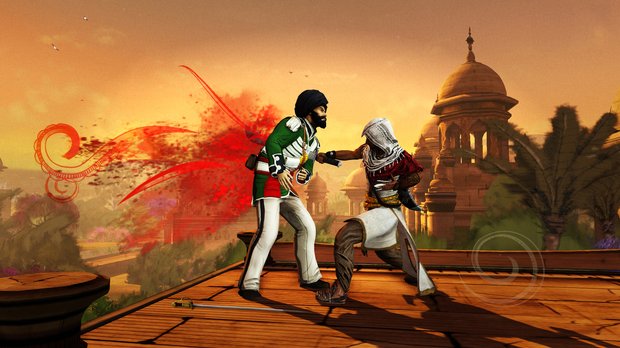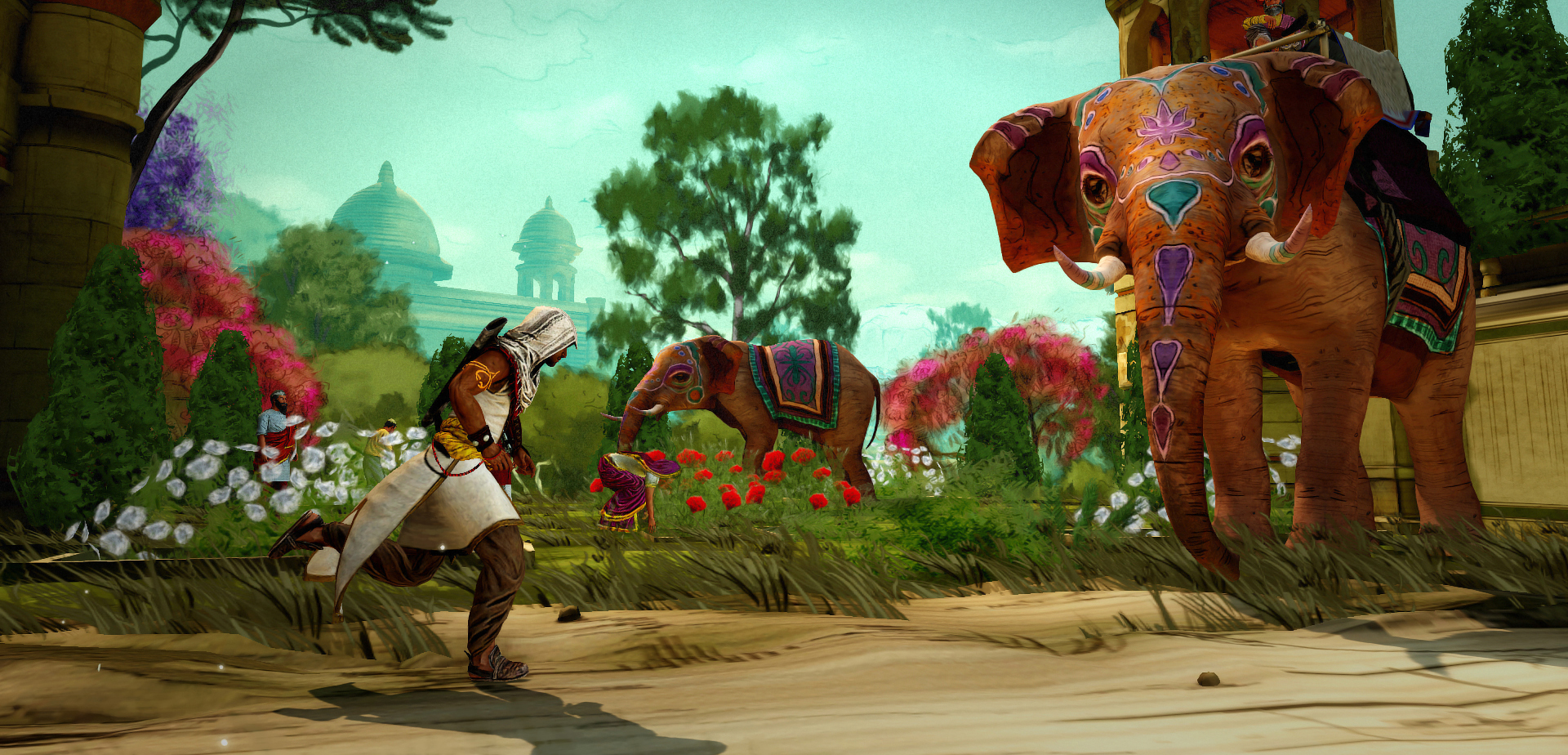GamesRadar+ Verdict
The beautiful landscapes of India and a promising sense of movement aren't enough to save Chronicles India from hamstrung combat and tedious stealth. Close, but missed the ledge.
Pros
- +
A gorgeous art style befitting the beautiful setting
- +
Smooth and satisfying movement
- +
A brand new location for the franchise
Cons
- -
Getting an automatic low score for engaging in combat
- -
Intentional speed bottlenecks
- -
A tissue-thin story
Why you can trust GamesRadar+
Assassin's Creed Chronicles: India, the second game in Ubisoft's 2.5D platforming mini-series, is the closest thing Assassin's Creed has to a pure stealth title. It doesn't abandon quick movement, but the two can work together well here, with kinetic energy bolstering your covert abilities. If the rest of the game played along, this could have been a welcome shift in tone for fans who prefer to sneak their way to victory. Unfortunately, Chronicles India has a nasty habit of getting in its own way, with finicky controls and an unforgiving level system making much of the adventure feel tedious. It's ultimately the lesser of the two Chronicles games, lacking where Chronicles China stands tall and offering little to make up the difference.
Set in the early years of India's colonial period, Chronicles India comes after the events of the Assassin's Creed Brahman comic, recording the artifact-chasing adventures of Kashmiri Assassin Arbaaz Mir. While some may recognize him as the father of AC Syndicate's bookish Assassin strategist, Henry Green, don't expect to dig deep into the Mir family legacy. A quick peek into the Assassin's Creed universe (at about eight hours long), Chronicles India is distinctly light on story, focusing primarily on Arbaaz's attempts to steal the magical artifact of the week - the Koh-i-Noor diamond, this time.
That's not a big deal if you're coming to Chronicles India primarily for acrobatics or to see how beautiful Assassin's Creed's India is - and it is gorgeous, with boldly-colored landscapes and splashes of Henna-inspired patterns making its finely-crafted artwork pop. However, look for anything heartier in this tale and you'll be disappointed by the time you put the controller down.

To a degree, that seems like the point, as puzzle-solving parkour is clearly Chronicles India's focus. In some ways, that attention pays off - Arbaaz's movements have a natural flow, creating the perceptible smoothness that constant motion should have. That's particularly clear in timed levels when the course allows for true free-running, letting you bound over collapsing platforms or slide beneath toppled pillars just in time to dodge the rampaging elephant on your tail (there had to be at least one). Not surprisingly, these levels are easily the most fun and satisfying of the bunch, though stealth sections that make room for that momentum also benefit - when you can whistle at one window, slide through the one next to it, and steal a precious artifact from right under a guard's nose, the Smooth Criminal jokes flow.
Sadly, Chronicles India tries far too often to slow your progress. While stopping to consider how to get past a pack of guards is perfectly fine, sentinels are often positioned in such a way that you have to hunker down while you wait for them to clear the only available path, cutting off the game's precious momentum. Because Chronicles India doesn't rely on the heart-pounding tension of almost getting caught that most stealth games do, cooling your heels drains you of nervous energy instead of ramping it up, so these sequences feel like unnecessary roadblocks rather than challenges to be overcome. Not all of the stealthy portions bring you to a grinding halt this way (some actually encourage you to use your speed to dodge past obstacles and guards), but knowing the game can do better makes these sequences stick out even more. The worst, however, are puzzles that force you to wait on giant shifting platforms, often plopped down in the middle of timed sections, creating an artificial means of slowing you down when that should not be happening.

It's also in these sections where the otherwise fine controls start causing problems. Trying to assassinate your target from a ledge is a pain when Arbaaz jumps instead of hanging, and getting killed when he only attacks one target after you painstakingly set up a double-assassination is the stuff deep sighs are made of. While there is an improvement over the controls in Chronicles China (I never got stuck because Arbaaz couldn't climb from the ceiling to the wall), the issues that remain aren't any less frustrating.
That, however, isn't Chronicles India's biggest flaw - that honor belongs to its combat, and uncertainty about how brawling should figure into the action. Most of the time the game discourages fights outright, giving you so little health you can be killed by a single shotgun blast even in late sections of the game. Plus, while your level score is based on how well you perform in one of three stealth-based categories (Shadow if you're never seen and kill no one; Assassin if you're never seen but do kill; and Silencer if you're never seen and choose to knock your victims out instead), being spotted by a guard or getting into a fight automatically kicks you down to the lowest possible score in the Shadow category. That isn't the case in timed sections, where your score is based on how fast you finish, but in every other situation fighting means an instant downgrade.

While that wouldn't be a big deal if high scores were treated as optional, the upgrades you get for a stellar performance are so critical to future missions that it's difficult to proceed without them; you're not so much rewarded for a job well done as punished for anything less, so getting into fights is akin to failure. That can mean repeating missions over and over until you can do them without being spotted, which quickly becomes a tedious exercise. That is, until the game wants to push you into a fight, which feels so counterintuitive to everything else you've done that it's hard to enjoy.
Ultimately a simple platformer with some good ideas and lovely art style, Chronicles India stumbles because its different pieces don't work together cohesively. It's worth a play if you absolutely must partake of every Assassin's Creed game, or if you're a determined stealth aficionado willing to overlook its flaws. Otherwise, just stick to Chronicles China - you'll be happier in the end.
This game was reviewed on Xbox One.
More info
| Genre | Action |
| Description | The second game in Ubisoft's 2.5D platforming mini-series, Assassin's Creed Chronicles: India sees the Assassins racing Templars for ownership of the Koh-i-Noor diamond. |
| Franchise name | Assassin's Creed |
| Platform | "Xbox One","PS4","PC" |
| Alternative names | "Assassin's Creed India" |
| Release date | 1 January 1970 (US), 1 January 1970 (UK) |
Former Associate Editor at GamesRadar, Ashley is now Lead Writer at Respawn working on Apex Legends. She's a lover of FPS titles, horror games, and stealth games. If you can see her, you're already dead.




